Education Reform
Seen Through The Eyes of a Mime-Dancer
By KAREN MONTANARO
March, 2013
A classroom of 2nd graders watches attentively as I show them a series of ballet steps. “Ballet,” I explain, “is supposed to be beautiful. But mime is not always beautiful, particularly if you want to be a lizard.”
I then hunker down in a wide stance and lean forward, arms lizard-like in front of me. I turn my face to the floor, hiding my expression as I spread my lips wide and flare my neck. When I lift my head, the audience gasps, laughs and leans forward. A predictable hush falls over the room as I stand there, letting my gears shift and breathing change.
I watch my audience as intently as they watch me. I see their eyes get big and their jaws drop. As I trundle toward them on my belly, several of them draw back, smiling but cautious. When I’m done, the kids breathe a sigh of relief and clap wildly. One boy seems too stunned to clap. Over the sound of applause, he blurts, “I saw you turn GREEN!!!!”
I can assure you I have not mastered the art of turning green, but this boy saw me turn green. In all my career, this is one of my favorite reviews. It also illustrates an essential aspect of the art experience. The arts are mirrors through which we see ourselves.
KEYNOTE PRESENTATION
Two years ago, I was asked to give a keynote presentation on the importance of arts in education. I welcome these opportunities to share my stories and observations with people. I knew that my keynote would fly.
The person who hired me was less sure. She didn’t doubt my ability, but she knew what kind of audience I’d have. “The people in your audience are regular classroom teachers who have very little interest in the arts.” Later I learned that members of my future audience had already asked for a furlough day, so that they could go Christmas shopping instead of sit through “another boring lecture.”
Standing on stage that morning of December 21st (my 50th birthday), I watched these teachers and administrators file into the auditorium. I have never seen lambs going to slaughter, but I recognized the scene immediately. My audience looked tired, overwrought and irritable. I smiled at people as they came in and not one person smiled back. Many of the eyes were vacant. And the few eyes that met mine, stared back as if to say, “There’s our keynote speaker.”
Fortunately, the still, small voice in my head was there to translate this scene for me, ‘Karen, these people are not angry with you. They don’t KNOW you. They don’t resent the arts. They’d rather be Christmas shopping and who can blame them? You’ll be fine.’
I knew I’d be fine. I trusted my personal stories to carry the day. I told them about the life-changing moment in a ballet class when I finally mastered the waltz turn. I told them about the personal crisis I went through as a professional ballet dancer, when I realized I’d never live up to my own expectations. I told them about my arts education that began when a beloved mentor told me to express myself when I danced. Finally, I told them how I work with teenagers -- how I see them as volcanoes of pressurized energy, sedated by technology (maybe), but still intense and ready to explode in socially-acceptable ways. When my keynote was over, the audience gave me a standing ovation and cheered. Several of them approached me with teary eyes and hugs. My break-out sessions afterwards were packed.
And then it was over. We all went home and resumed our lives.
I came away from this triumphant experience with more questions than answers. I asked myself, ‘Why . . . when there are so many arts initiatives at the federal, state and local levels,
so many scholarly articles, arguments, speeches, keynotes, so many compelling stories of lives changed by the arts, . . . why are the arts still cut from school budgets?’
ARTS ADVOCACY
Nick Rabkin, Arts Education Specialist from the University of Chicago, writes:
"Advocates for arts education have long made an ESSENTIALIST argument for the arts: they are such an important dimension of life that they must be included among core academic subjects. Their efforts have been rewarded by inclusion of the arts as a core subject in federal legislation.”
Mr. Rabkin also states, “Including the arts in federal education legislation is, in the end, lip service.”
Mr. Rabkin brings up an important point. Namely that advocates for arts education want the arts to be “included among core academic subjects.” But this is like trying to fit round pegs in square holes. The arts are a totally different breed of subjects, no less important than core academic subjects but totally different.
Today, arts advocates maintain that politicians and educators WILL support the arts, as soon as there’s quantitative proof that the arts support them. So arts advocates talk-the-talk of politics and walk-the-walk of education and fund research that will (they hope) prove how important the arts are to both.
But such research will never do justice to the arts. At best, it will only prove only how well the arts serve purposes other than their own.
The arts cannot do their vitally important job while parading around as economy-boosters or student-achievement builders. The arts do many wonderful things for this world precisely because they remain faithful to one cause and only one cause . . . that of inspiring, uplifting, enhancing, informing, revealing and expressing the individual’s experience.
I believe that once we let the arts do their job, our economy will boom, our kids will perform better on tests and humanity will celebrate. But these will be side-effects, only when they stop being ultimate goals.
Education reform is possible through the arts. It’s a matter of defining our terms correctly and putting things in right relation to each other. As I see it, everything is set and ready to go.
DEFINING TERMS
ARTS and ARTS EDUCATION
The arts are not core academic subjects so much as they are channels of self-expression.
Even the academic, standards-based aspect of arts education (that is, the learning and perfecting of technique) is important only as it allows the individual to understand and express him/herself in more original and universal ways.
As channels of self-expression, the arts are as vital to life as the channels carrying air in and out of our lungs. They facilitate a type of education that is developmentally and rigorously aligned with our inner lives, from childhood to adulthood, through retirement and beyond.
We come into this world singing, dancing, painting, building things, explaining things. We’re natural mimes and storytellers. We recite and make up poetry. I believe we’re endowed with this bold expressiveness for a reason and we need to maintain it, even as we learn to work with others and get along in the world.
In order to build on our natural expressiveness, an arts education must keep pace with children, designing arts-related challenges that fit the age. In my experience, I’ve found that young children imitate everything with mind-boggling accuracy. 3rd, 4th, 5th graders have recently acquired a certain mastery over their bodies and their movements. They’re ready to take on challenges that demonstrate and develop this mastery. High school kids are verbal, hormonal and dramatic. Their issues have suddenly taken on epic proportions.
EXAMPLES OF ARTS EDUCATION
Arts education is the cultivation and expression of the individual’s experience through art.
In light of this definition, it’s possible to find examples of quality arts education happening all over the country. Here are a few:
Recently my friend, Andrew, and I watched an elderly teacher guide a group of students through an exhibit at the Metropolitan Museum of Art in NYC. The students looked to be about 10 or 11 years old. They shuffled into the room and gravitated toward the only bench. Before all of them flopped themselves on the bench, their teacher called them over to a painting by Vincent van Gogh. The kids shuffled over to the painting.
The teacher then asked them how much paint they saw on the canvas. They agreed that there was a lot of paint on the canvas, “Gobs of it!” She then took a paint brush out of her bag and invited someone (anyone) to take the brush and imitate the paint strokes they saw in the painting. Several students eagerly volunteered to show this. The kid who ended up with the brush, mimicked the strokes that he saw. The teacher said, "Yes, that's it! Everybody try!" Instantly all of the students mimed a flurry of strong, deliberate paint strokes.
This is an example of an arts education sharpening the senses. Sandra K. Trenfor states, “The best teachers are those who show you were to look, but don’t tell you what to see.”
In this instance, the teacher invited her students to look at the painting. She didn’t tell them that van Gogh used lots of paint; she let them see that for themselves.
This teacher also invited her students to experience the energy and physicality that characterize van Gogh’s artistry. When kids move, they feel. By imitating van Gogh's paint strokes, they felt a bit of the energy he must have felt when he painted. In many ways, this art lesson was a lesson in empathy.
It’s not possible to teach "empathy" by using the word in a sentence and testing kids on it. In fact, this teacher may not have been aware of how empathy figured into her lesson. But as a movement teacher, I recognized the movement-empathy connection immediately.
Another example of high quality arts education is the PS 22 Chorus, an elementary school chorus from Staten Island, NY directed by Gregg Breinberg.
Even though the kids were sitting down, I was blown away by how they moved and the feeling they expressed!
Each member of the chorus moved in his or her own way, spontaneously, freely, expressively, continuously. The movements themselves were thrilling to see. But I was also thrilled to see that no one seemed at all critical of how anyone else moved. There were no side-long glances at each other. No nervous giggles. No rolling of eyes. Everyone let Everyone Else be bold, expressive, original and spontaneous.
Finally, one of my favorite examples of a true-blue arts education is the National Dance Institute, based in New York City.
After one of NDI’s end-of-year performances, I was moved to write a letter to Jacques d’Amboise, NDI’s founder. I wrote:
Watching [this performance], it became crystal clear to me that every child not only deserves the NDI experience, every child actually NEEDS it! This experience is not a luxury; it’s a necessity.
It’s a necessity because NDI gives young people a chance to tap into and express what they do best and that is MOVE! They move energetically, intelligently, musically, rhythmically, expressively, exuberantly, both as soloists and as members of an ensemble. When children are allowed to do what they do best, they are allowed to be themselves, to know themselves, to feel good about themselves and to apply themselves to whatever they do.
This performance presented a vision of freedom. Watching each one of the 300 children shine with an eternal light, seeing even the children in the back as engaged and as radiant as the children in front, hearing the roar and whistles of the audience immediately responding to each child’s stellar performance, I began to understand why your vision 35 years ago continues to exceed expectations every year.
Examples of high-quality arts education are everywhere, but it’s the kind of quality that can’t be measured in numbers or plotted on grafts. It’s evidenced by watching kids in action . . . using nature’s assessment tools of body language, facial expression and behavior.
Arts education is not always exhilarating or immune to frustrations. In fact, the arts take kids through the full gamut of experiences, offering developmentally appropriate ways for kids to be themselves and improve themselves at the same time.
STANDARDS-BASED EDUCATION & ART EDUCATION
A VITALLY IMPORTANT RELATIONSHIP
As channels of self-expression, the arts are more important for young people now than they ever were.
Technology is rapidly and dramatically changing how kids express themselves. Facebook, twitter, texting and video games are popular vehicles of self-expression. Likewise, the media is constantly teaching kids what kind of “selves” they need to be in order to fit in. I believe that kids are subject to so many subliminal, cyber-forces now that they often don’t know which end is up. Many of them have trouble holding down jobs, performing well in school and having healthy relationships.
The arts can help regular classroom teachers do their vitally important job. They can help them teach science, technology, engineering and math. But this is not their most useful application. The arts help teachers by helping their students.
THE ART STANDARD
Arts education must be held to high standards in order to be useful to education. But the art standard is its own kind of standard. It’s unique in that it refers to the individual’s experience.
Emily Dickinson defined the highest art standard when she said, "When I feel physically as if the top of my head were taken off, I know it's poetry."
I first heard this quote while serving on a panel of judges for the Maine Arts Commission. Our job was to assess works of art and deem them worthy (or not) of a particular type of recognition. We reserved the “Dickinson Distinction” for those rare instances when a work of art made us “feel physically as if the top of [our] heads were taken off.”
We judged close to 500 applications that day. Our process was streamlined and efficient. We sailed through the applications, sampling only a few seconds of each video or slideshow before deciding “yay” or “nay.” Then a video started playing that stopped us cold. Of one accord, we dropped our pencils and watched the entire video without breathing. When it was over, no one spoke. There was no discussion. Eventually someone said, “Dickinson Distinction” and we moved on.
What struck me about this moment was how unanimous it was. There was nothing random or haphazard about our assessment. We agreed on the Dickinson Distinction without controversy or discussion. This work of art took us out of our heads . . . beyond our tastes and opinions to the ultimate goal of art . . . a transcendent, physically felt experience.
(Page 2 Click Here)
Return to School Programs.

CLICK HERE
Karen's Public Speaking Program
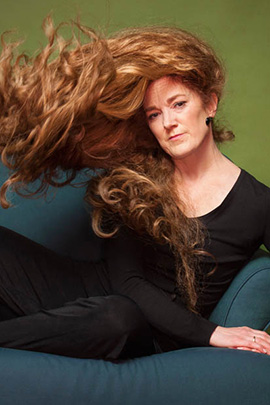
New Promo Pics Click Here!
Photocredit: George C. Anderson
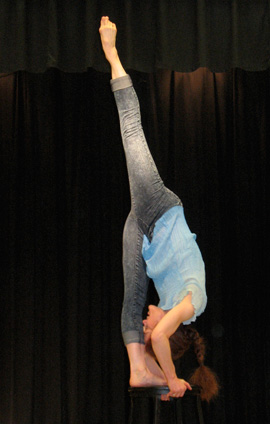
A Visit to Sanford (News Article)
Photocredit: Argy Nestor
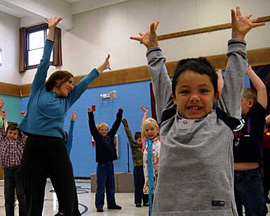
Bringing Magic (News Article)
Photocredit: Times Record
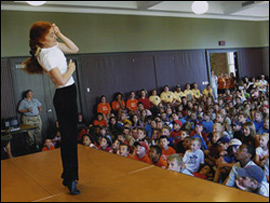
School Assemblies Click Here!
Photocredit: The Sun Journal

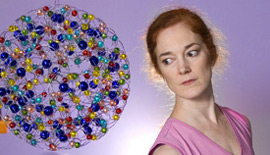
A Dance To Touch The Soul
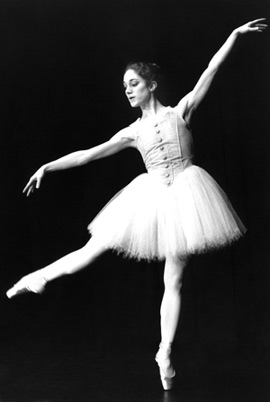
Concerts CLICK HERE!
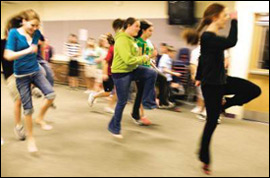
Workshops CLICK HERE!
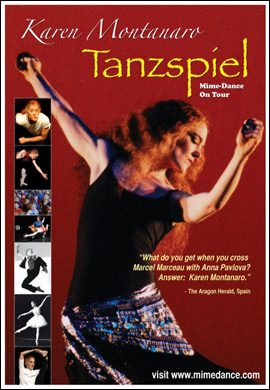
Presenter Resources CLICK HERE!
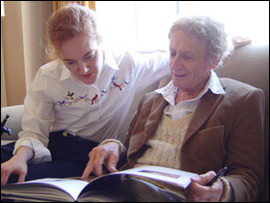
Karen with Marcel Marceau
Read More in "Backstage"